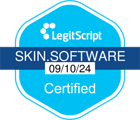In recent years, we've all become much savvier to the damaging effects of long-term (and sometimes short-term) sun exposure. Long gone are the days that we bathe under the rays smothered in oil — and thank goodness for that.
It's not just red sunburn that can appear on your skin after unprotected sun exposure, you might notice pigmentation pop up on your skin as well. Sun pigmentation or sun spots pigmentation involves the discolouration of skin from the sun and often looks like dark spots or patches of uneven skin tone.
Sun exposure isn't the only cause of pigmentation, either. Learning the causes of dark spots can help in the prevention of further pigmentation as well as ways to treat it.
So, if you notice pigmentation and want to learn how to prevent hyperpigmentation in the future — as well as manage it — read on.
What is hyperpigmentation?
Hyperpigmentation is used to describe dark spots of skin from an overproduction of melanin [1]. Pigmentation can also be known as age spots (or sun spots), melasma or post-inflammatory pigmentation.
In order to treat pigmentation, you need to determine what is causing the production of extra melanin.
Things that can cause this include:
- Sun exposure leading to sun damage
- Acne scarring
- Hormonal changes
- Medical conditions, for example, some chemotherapy drugs have been known to cause temporary pigmentation
- Pregnancy
While it can affect your confidence, know that it is a common skin condition and there are lots of things we can do to treat hyperpigmentation and prevent hyperpigmentation from returning.
Can sun exposure give you hyperpigmentation?
While sun exposure doesn't necessarily cause hyperpigmentation, excessive sun exposure and getting burnt can lead to post-inflammatory hyperpigmentation [2].
Sun exposure can cause an increase in melanin production, which is brown pigment cells, in order to protect itself from the sun. This can lead to an uneven skin tone, sun spots or dark spots and darkened skin.
Avoiding prolonged exposure and never going out in the sun without proper protection (SPF and protective clothing) will also help you prevent any dark spots.
Sun protection is key to avoiding both dark spots or post-inflammatory hyperpigmentation as well as more concerning things like skin cancer, too.
Melasma sun damage
Melasma is a skin condition that causes brown spots or patches on the skin [3]. It can affect people at different stages of their lives and is commonly experienced by the following groups:
- People with darker skin tones
- People engaged in hormone therapy
- Women who use birth control pills
- Pregnant people, which is why you might hear it referred to as the "pregnancy mask".
One study found that 90% of melasma cases are women but men can also experience this skin condition too [4]. If you're experiencing melasma, exposure to the sun can make it worse.
How long can sun discolouration last?
The good news is that sun spots can fade over time, but they might not necessarily disappear completely. When you figure out what's causing the hyperpigmentation and you stop what it is — for example, not going in the sun — fading can start to happen.
Depending on how dark your spots are, they can take from 6-12 months to fade. But, if the colour is significantly darker than your natural skin colour, it could take years.
This is why it's super important to focus on how to prevent hyperpigmentation [5].
How do I prevent and treat sun pigmentation?
There are a number of things you can do to both prevent and treat existing sun pigmentation — and don't worry, they don't all involve staying indoors all day and hiding from the daylight.
The key is to protect your skin. Your skin is a delicate organ and we should look after it as such. Prevention is always the best line of defence but we also have some tips for how best to replenish the skin after noticing pigment-producing cells.
Protect your skin from the sun
Sun protection is the key to healthy skin cells. To prevent hyperpigmentation, avoiding the sun, wearing sun protection, protective clothing and broad-spectrum sunscreen of at least SPF30+ are necessary.
Sunscreen should be worn every single day and needs to reapplied every 2 hours to provide continued protection.
Software’s Daily Sun Defence SPF50+ is non-comedogenic and its broad spectrum protects against UVA and UVB rays. Designed for sensitive and acne-prone skin, it can aid in the prevention of premature skin ageing, sunspots and solar keratosis.
Use vitamin C
Vitamin C is an important ingredient in your skincare regime as it helps obstruct melanin production by suppressing an enzyme called tyrosinase. This vitamin is adored in the dermatology world, for good reason, as it reduces pigmentation of existing spots on your skin.
Software's Vitamin C + Ferulic Serum brightens and firms skin, reduces fine lines and evens your skin tone thanks to a full 15% of vitamin C included in the formula.
This vitamin C serum helps to combat dark spots, discolouration and dullness within the skin while also protecting your skin cells from free radicals caused by UV rays.
Custom skincare treatments for stubborn skin discolouration
Looking for the right skincare routine for different types of pigmentation such as melasma, dark spots or post-inflammatory hyperpigmentation can feel daunting. Where do you start?
Software's personalised pigmentation treatment takes your skin goals into account and treats your skin concerns — like hyperpigmentation or age spots — with specialised ingredients.
Our Australian health practitioners design your formula based on where your skin is at. Simply take our online consultation and our practitioners can create a treatment just for you.
Photo credit: Getty Images
References
- https://www.ncbi.nlm.nih.gov/pmc/articles/PMC8776661/
- https://www.mayoclinic.org/healthy-lifestyle/adult-health/multimedia/sun-damage/sls-20076973
- https://www.mayoclinic.org/healthy-lifestyle/adult-health/multimedia/sun-damage/sls-20076973?s=7
- https://www.aad.org/public/diseases/color-problems/melasma#causes
- https://www.aad.org/public/everyday-care/skin-care-secrets/routine/fade-dark-spots

Real people, incredible transformations
backed by dermatologists
Software for ageing concerns, June 2022


Software for ageing concerns, June 2022




.avif)



















.svg)